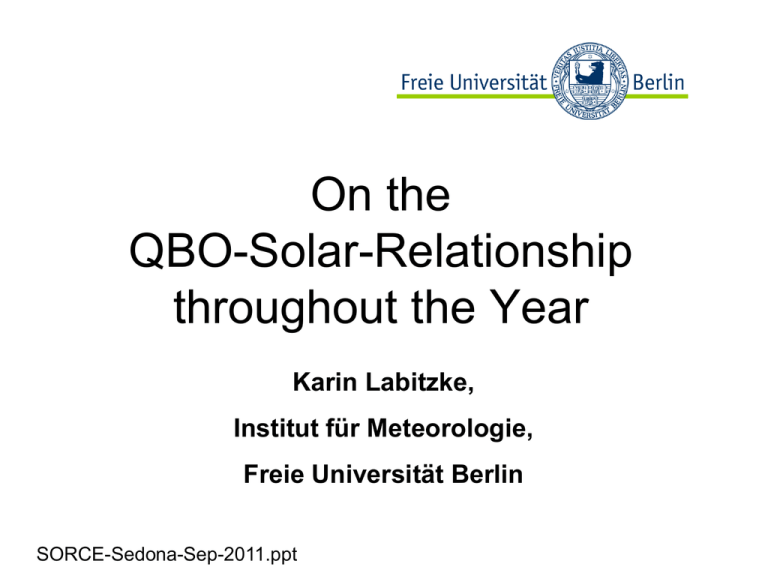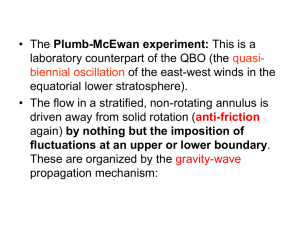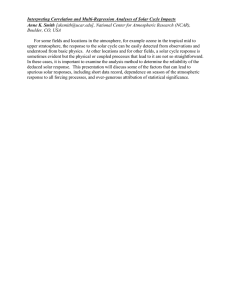On the QBO-Solar-Relationship throughout the Year
advertisement

On the QBO-Solar-Relationship throughout the Year Karin Labitzke, Institut für Meteorologie, Freie Universität Berlin SORCE-Sedona-Sep-2011.ppt Today, I want to tell you about the importance of the QBO and of the Sun for the understanding of the variability of the stratosphere in summer and in winter. 2 Vertical meridional sections of the standard deviations of temperatures (upper panel) and heights (lower panel) JUL <1.3 K < 1K Temp (K) <1K for JULY 1948 – 2007; n=59 y Height < 40m (Labitzke and van Loon, 1999) 3 1953 Quasi-Biennial Oscillation QBO (1953 – 2011) Time- height section of monthly mean zonal winds (m/s) at equatorial stations: Canton Island (3°S / 172°W) (Jan 1953 – Aug 1967); Gan/Maledive Islands (1°S /73°E) (Sep 1967 – Dec 1975); Singapore (1°N /104°E) (since Jan 1976). Isopleths are at 10 m/s intervals, westerlies are shaded ; (updated from Naujokat 1986). (grey = west; white = east) 4 The Quasi - Biennial Oscillation (1993 – 2011) QBO-definition for the winter: (50+40hPa in Jan+Feb) / 4; (Holton and Tan, 1980); grey = west wind, white = east wind 5 Values of the Solar Constant of Radiation (calories) for the Period 1905 – 1912, (Abbot et al.,1913) (general understanding at the time: in solar maximum less radiation because of many spots (dirty) and in minimum more radiation because of clean face6 of the sun) Percentage UV Radiation Differences between Solar Maxima and Minima Solar Maxima: more UV radiation more UV = more Ozone in the stratosphere 7 Data from Lean et al. , 1997 (positively correlated with the UV part of the solar spectrum) Monthly mean (blue) and smoothed (red), positively 8 correlated with UV part of the solar spectrum Today, there is general agreement that the variable sun is responsible for a large part of the variability of the temperatures and winds,observed especially in the stratosphere over the tropics and subtropics, in summer, but the phase of the QBO must be considered, too. 9 all Time series of the 10.7 cm solar flux (red lines); detrended 30-hPa temperatures (blue lines) in July, at the grid point 20S/57.5 W, Campo Grande/Brazil r = correlation coefficients r = 0.91 east upper panel = all data, n=43 years; middle panel = only years in the east phase of the QBO, n = 20 years; west lower panel = only years in the west phase of the QBO, n=23 years; (50+40 hPa)/2 is used for July. (NCEP/NCAR: 1968-2010) Labitzke and Kunze, JASTP, 2011) 10 HOUSTON / TEXAS ALL 30°N /95°W EAST r = 0.83 WEST 11 Correlations Differences: solar max-min 30 hPa ALL EAST max=0.93 WEST JULY: red: corr.>0.4 (blue=temp. diff. > 1K) 12 3 Correlations (red = > 0.4) delta T (°C): solar max –13min 32~km shading is +/- 1 standard deviation + 3.5 K DELTA T: solar max – solar min 14 JULY Correlations Temp.Diff. max - min blue = >1K r=0.93 AUG r=0.89 SEP r=0.83 all are 30hPa and QBO/EAST OCT r=0.79 red= corr.>0.4 NCEP/NCAR, 1968-2009, 15 n = 42 years JUL 33 OCT 16 QBO- east wind is weaker in solar max because of the anomalous westwind; similarly: QBO-west wind is weaker in solar max because of the anomalous east wind Maps of 30-hPa height differences (geopot.m) in July between solar max and solar min. 17 EAST WEST eastwind u-diff = -13 m/s r = - 0.6 Scatter diagrams of the zonal wind (m/s) over the equator at (40+50 hPa)/2 in July (absolute values), against the 10.7 cm solar flux; period: 1953-2010; left: east phase of the QBO, right: winds in the west phase. (Data set FU-Berlin, Labitzke et al., 2002) 18 Equator Vertical profiles of the differences between solar max and solar min of the mean zonal wind (m/s) in July. (Grey shading indicates the range of +/- 1 standard dev.) Data: NCEP/NCAR re-analyses, 1968-2010. 19 So far, I concentrated on the Northern Summer, because I think that the solar signal is very clear and convincing during this time of year. I am turning now to the Northern Winter. Here we are dealing with the Arctic Polar Vortex and with the Major Midwinter Warmings. They are responsible for the tele-connections between the Arctic and the Tropics. 20 SO Cold event Warm event QBO Westphase Eastphase SUN Solar min Solar max cold and strong (Labitzke and warm and weak van Loon, 1987) cold and strong (Holton and Tan, 1980; warm and weak Data:1963-1978, n = 16) like QBO (Labitzke + van Loon, opposite to QBO 1987 – 2006) Different forcings influencing the stratospheric polar vortex during the northern winters 21 22 Arctic versus Tropics: r= -0.66 CH P A E E E E E E E E E E E E E E E E E E E E E E E = QBO eastphase E E E 23 red = warm event - SO blue = cold event - SO all: n = 59 r = 0.19 P Ch CH A A l min l max no correlation with 11-year solar cycle Tropical volcanoes W: Agung March 1963 E: Chichon March 1982 24 E: Pinatubo June 1991 11 n(all) = 70 winters Feb 2011: Solar min; QBO = West, = cold, strong vortex; n = 39 25 +11 + 5 strongest MMWs in east min nodal point lines: ~ 30S and ~ 55N in both cases -8 5 coldest winters in west min 90S 90N Deviations of the zonal mean temperatures (K) in (Jan+Feb)/2 from the long-term mean (1968 through 2002); (shading larger than 1 (2) standard deviations) 26 east/min: 5 strongest + 11 K MMWs - Composites of ~ ~ Temperature west/max: Anomalies 5 strongest MMWs +8K (Jan+Feb)/2 ~ ~ 27 Conclusion for the Winter •The QBO and 11-year Sun-Spot Cycle (SSC) explain a significant portion of the variance of the winter monthly values of Arctic temperatures, winds, and geopotential heights. •The behavior of the Arctic stratosphere is strongly related to the QBO phase and to the SSC, yet other factors such as internal variance also play an important role. •This emphasizes the probabilistic nature of forecasting Arctic stratosphere behavior. 28 Thank you for your attention 29 Labitzke and van Loon, 1999 30 31 32 33 34

